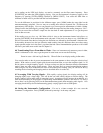5
Power dbm = 10 log (Power in watts/.001) or Power watts = .001 [ anti log ( power dbm/10) ]
Voltage dbv = 20 log (Voltage volts/Vr) or Voltage volts = Vr [anti log (Voltage volts/20)]
Vr = .775 volts for the A and B models: Vr = 1 volts or .775 volts can be selected on the C model.
For optimum accuracy the instrument takes measurements over a small part of it’s total –120dbm to
+20dbm measuring range by using a range selectable detector circuit. The selectable ranges are, 100db
and 10db and have resolutions of .1db and .01db respectively. The readings are accurate over the whole
10db range but are only accurate over the upper 80db of the 100db range. The location of a range within
the instruments total measuring range is operator or automatically selected for best level measurement
accuracy. This is done by using an IF amplifier circuit whose gain is accurately changed. The IF amp is
located just before the detector and changes its gain to select the upper limit for the range of values the
detector is measuring. Specifying an upper limit for a range using the entry command actually selects the
gain of the IF amplifier. Automatic limit selection is done using a circuit similar to the AGC circuit in a
radio receiver.
One important point to remember is that the upper limit for the 100db range can not be set below –45dbm
because –80db below this setting starts to equal the instrument’s noise floor of around –120dbm. When the
detector is set to the 10db range the upper limit can be set much lower to –120dbm. The SSB demodulator
receives its signal from the IF strip in parallel with the level detector and will only be able to demodulate
signals above –55dbm. When the instrument is in the 100db range the gain of the IF strip is too low to
read radio signals below this level. Therefore, when using the SSB detector for audio tuning of received
radio signals we should almost always have the instrument in the 10db range since these radio signals are
usually below –55dbm. In chapter 4 we’ll show how to work around this problem when receiving SSB
signals.
For those of us working on electronic circuits or taking radio signal measurements this instrument is a
valuable tool that can be used to measure RF or audio noise, the frequency of a received carrier, find and
measure spurious transmitter signals, provide a signal and detector system for circuit analysis, and as a
VFO to control the carrier of a transmitter. It will work as a SSB receiver over its whole frequency range
to tune on the air signals for measurement. It receives and accurately measures signals down to -100dbm,
which is much lower than the noise on most ham bands.
One disadvantage when receiving SSB signals is that the HP3586 will not output the actual carrier
frequency of a SSB signal to its rear panel Fo output when using the SSB detector. It only outputs the
center frequency of the selected band pass. In this document I will describe how to work around this
problem when controlling AM transmitters.
2.3 Instrument Accuracy - The instrument uses 100db or 10db changeable ranges for maximum
accuracy as described above. The 100db range is only accurate over its upper 80db portion and has a
resolution of .1db. In the automatic range limit control mode the 100db range will have its upper limit
automatically changed to always stay within the accurate upper 80db part of this range. The narrower
range of 10db has a resolution of .01db. The instrument’s level measuring frequency range is 200Hz to
32MHz with a frequency resolution of .1Hz and accuracy of + or - .000001 of it’s reading during the first
year after calibration. The 004 optional crystal frequency reference was offered for greater frequency
display accuracy, see Chapter 16, section 16.8 if your instrument doesn’t have this option.
The instrument is intended for accurate measurements only in the range of –100dbm up to +20dbm. Using
the 50 or 75 ohm input from 200Hz to 32MHz and for signal levels between +20dbm and –80dbm,
between –80db and –100db its accuracy is +/- .75dbm. From 200Hz to 200KHz and from +20dbm to –
80dbm its level accuracy drops to +/-.40dbm, and from –80dbm to –100dbm it’s +/-.95dbm. Below
100dbm it’s accuracy isn’t rated and level measurements below –100dbm should not be trusted even
though the instrument will appear to read down to its noise floor of around –120dbm. By using


















